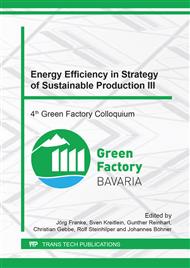p.193
p.199
p.208
p.220
p.230
p.237
p.244
p.252
p.262
Recycled Plastic Beads Sorting Machine for Polypropylene and Acrylonitrile Butadiene Styrene Type with Difference of Density
Abstract:
This study aims to design and develop the recycled plastic beads sorting machine for 2 types of plastic beads, which are PP (Polypropylene) and ABS (Acrylonitrile butadiene styrene). Due to the process of preparing plastic materials for producing fan tube and base parts of electric fan, plastic beads scraps has been generated. Presently, the company has separated these scraps with manual method. The workers have stirred them with water for separating scrap types by difference of density. They have operated this process in the overtime period. In addition consuming processing time, this process makes fatigue effect in operators and also consume amount of water for each cycle of separating. Therefore, sorting machine for replacement workers has been developed. It can work for more efficiency than the previous method by reducing processing time by 41.8%. The proposed machine consists of 2 tanks for separating two types of plastic beads at capacity 50 Kg/hr. At the end of each cycle, the water consumed in the previous cycle can be reused. As this method, the proposed machine can reduce consuming water approximately 88.43%. This machine can reduce the number of operators from 2 to 1 person. Finally, payback period for recovering investment of machine comparing with saving labor cost is 1.48 months.
Info:
Periodical:
Pages:
230-236
Citation:
Online since:
October 2017
Price:
Сopyright:
© 2017 Trans Tech Publications Ltd. All Rights Reserved
Share:
Citation:


